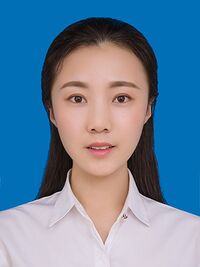CAZypedia celebrates the life of Senior Curator Emeritus Harry Gilbert, a true giant in the field, who passed away in September 2025.
CAZypedia needs your help!
We have many unassigned pages in need of Authors and Responsible Curators. See a page that's out-of-date and just needs a touch-up? - You are also welcome to become a CAZypedian. Here's how.
Scientists at all career stages, including students, are welcome to contribute.
Learn more about CAZypedia's misson here and in this article. Totally new to the CAZy classification? Read this first.
Difference between revisions of "User:Jingjing Shen"
Harry Brumer (talk | contribs) (Created page with "200px|right '''This is an empty template to help you get started with composing your User page.''' You should begin by opening this page for ed...") |
|||
| (12 intermediate revisions by the same user not shown) | |||
| Line 1: | Line 1: | ||
| − | [[Image: | + | [[Image:Shen.jpg|200px|right]] |
| − | + | Jingjing Shen is currently a Ph.D. student at the College of Food Science and Engineering, Ocean University of China, under the instruction of Prof. Yaoguang Chang. Her research focuses on the gene-mining and characterization of glycoside hydrolases. She discovered and characterized the first member of [[GH168]] <cite>Shen2020</cite>, [[GH174]] <cite>Liu2023</cite> and [[GH187]] families <cite>Shen2024</cite>, and contributed to the studies related to members of the following families: | |
| − | + | *[[GH16]]: κ-carrageenase Cgk16A <cite>Shen2018</cite> | |
| − | + | *[[GH82]]: ι-carrageenase Cgi82A <cite>Shen2017</cite> | |
| − | + | *[[GH168]]: endo-1,3-fucanase Fun168A <cite>Shen2020</cite> | |
| − | * | + | *[[GH174]]: endo-1,3-fucanase Fun174A <cite>Liu2023</cite> |
| − | * | + | *[[GH187]]: endo-1,3-fucanase Fun187A <cite>Shen2024</cite> |
| − | * | ||
| − | |||
| − | |||
| − | |||
| Line 15: | Line 11: | ||
<biblio> | <biblio> | ||
| − | # | + | #Shen2020 pmid=32849348 |
| − | + | #Liu2023 pmid=36746582 | |
| + | #Shen2024 pmid=37940306 | ||
| + | #Shen2018 pmid=29355636 | ||
| + | #Shen2017 pmid=28760444 | ||
</biblio> | </biblio> | ||
<!-- Do not remove this Category tag --> | <!-- Do not remove this Category tag --> | ||
[[Category:Contributors|Shen,Jingjing]] | [[Category:Contributors|Shen,Jingjing]] | ||
Latest revision as of 01:02, 27 December 2023
Jingjing Shen is currently a Ph.D. student at the College of Food Science and Engineering, Ocean University of China, under the instruction of Prof. Yaoguang Chang. Her research focuses on the gene-mining and characterization of glycoside hydrolases. She discovered and characterized the first member of GH168 [1], GH174 [2] and GH187 families [3], and contributed to the studies related to members of the following families:
- GH16: κ-carrageenase Cgk16A [4]
- GH82: ι-carrageenase Cgi82A [5]
- GH168: endo-1,3-fucanase Fun168A [1]
- GH174: endo-1,3-fucanase Fun174A [2]
- GH187: endo-1,3-fucanase Fun187A [3]
- Shen J, Chang Y, Zhang Y, Mei X, and Xue C. (2020). Discovery and Characterization of an Endo-1,3-Fucanase From Marine Bacterium Wenyingzhuangia fucanilytica: A Novel Glycoside Hydrolase Family. Front Microbiol. 2020;11:1674. DOI:10.3389/fmicb.2020.01674 |
- Liu G, Shen J, Chang Y, Mei X, Chen G, Zhang Y, and Xue C. (2023). Characterization of an endo-1,3-fucanase from marine bacterium Wenyingzhuangia aestuarii: The first member of a novel glycoside hydrolase family GH174. Carbohydr Polym. 2023;306:120591. DOI:10.1016/j.carbpol.2023.120591 |
- Shen J, Zheng L, Zhang Y, Chen G, Mei X, Chang Y, and Xue C. (2024). Discovery of a catalytic domain defines a new glycoside hydrolase family containing endo-1,3-fucanase. Carbohydr Polym. 2024;323:121442. DOI:10.1016/j.carbpol.2023.121442 |
- Shen J, Chang Y, Chen F, and Dong S. (2018). Expression and characterization of a κ-carrageenase from marine bacterium Wenyingzhuangia aestuarii OF219: A biotechnological tool for the depolymerization of κ-carrageenan. Int J Biol Macromol. 2018;112:93-100. DOI:10.1016/j.ijbiomac.2018.01.075 |
- Shen J, Chang Y, Dong S, and Chen F. (2017). Cloning, expression and characterization of a ι-carrageenase from marine bacterium Wenyingzhuangia fucanilytica: A biocatalyst for producing ι-carrageenan oligosaccharides. J Biotechnol. 2017;259:103-109. DOI:10.1016/j.jbiotec.2017.07.034 |
